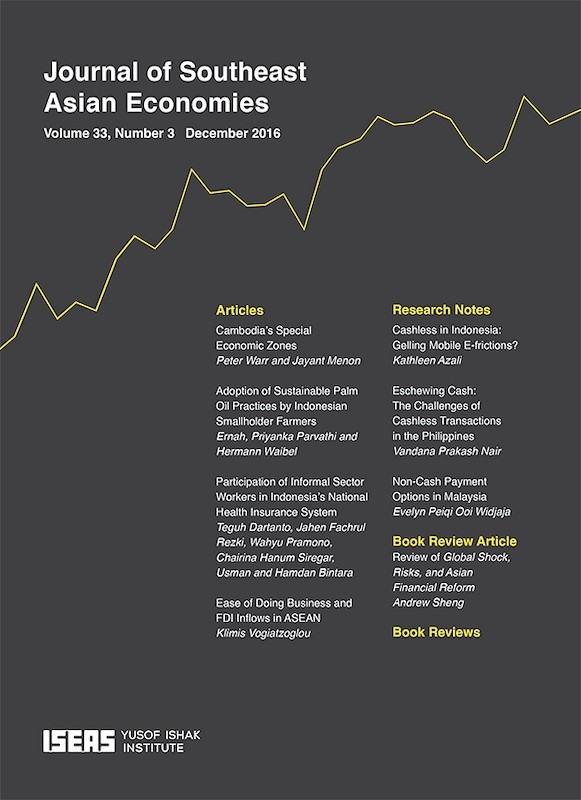Journal of Southeast Asian Economies Vol. 31/1 (Apr 2014). Policy focus on "Building Social Protection Systems in Southeast Asia"
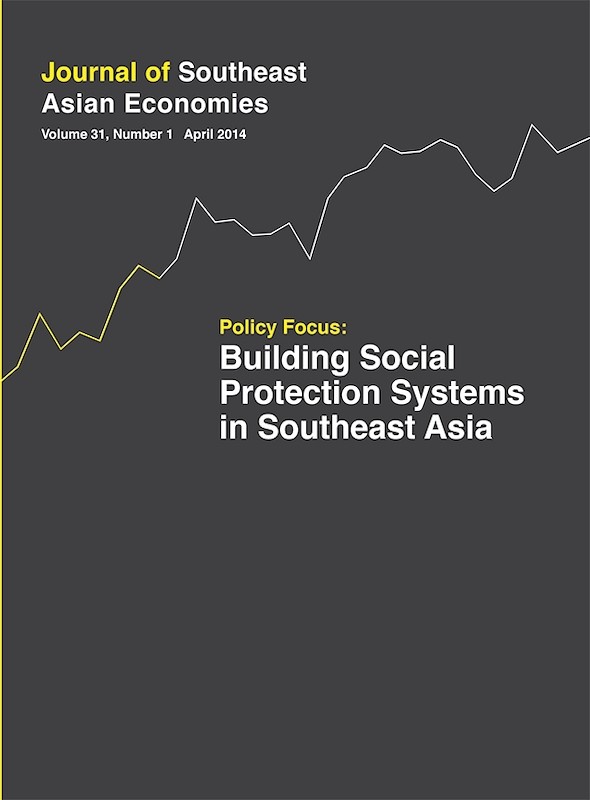
Jonathan Pincus, editor
Date of publication:
April 2014
Publisher:
Institute of Southeast Asian Studies
Number of pages:
163
Code:
AE31/1
Contents
-
Journal of Southeast Asian Economies Vol. 31/1 (Apr 2014). Policy focus on "Building Social Protection Systems in Southeast Asia"
[Whole Publication] -
Preliminary pages
- POLICY FOCUS ARTICLES
-
Poverty, Inequality and Social Protection in Southeast Asia: An Introduction, by Sarah Oh, Jonathan Pincus, authors see abstractSocial protection programmes have expanded rapidly in the developing world in recent years. In Southeast Asia, the experience of the Asian Financial Crisis of the 1990s heightened awareness of vulnerability to poverty and the role of government in protecting households from a sudden loss of employment and income, or from contingencies such as ill-health and ageing. Most governments have expanded targeted social assistance programmes, although the quality and coverage of these programmes vary from place to place. Public support for basic health and education services is also uneven. Common challenges in the region include economic risks associated with financial globalization, rapid urbanization, high levels of informal employment, rising dependency ratios and a highly unequal gender division of labour.<br><br>
-
Social Protection, Poverty and Inequality: A Comparative Perspective, by Simone Cecchini, author see abstractOver the last thirty years, economic growth, job creation and poverty reduction rates in Latin America and the Caribbean (LAC) have been much lower than in East Asia. However, thanks to democratization, the end of structural adjustment policies and renewed economic growth since 2002, LAC has succeeded in reducing poverty and inequality, one of the region’s seemingly intractable problems. Growing public social investment and the extension of social protection have both supported this development. Social protection measures have included innovative poverty reduction programmes, such as conditional cash transfers and non-contributory pensions for the elderly and disabled. Today, building on this progress, several LAC countries are moving towards comprehensive social protection systems, which entail the adoption of universal policies and safeguarding citizens’ social and economic rights. Given the challenges that many Southeast Asian countries are still facing in this respect, it is thus worth assessing the extent to which social protection has contributed to reducing poverty and inequality in LAC.
-
Social Protection in Indonesia and the Philippines: Work in Progress, by M Ramesh, author see abstractThe paper examines social protection programmes for the poor, aged and sick in Indonesia and the Philippines with the purpose of assessing their performance in effectively protecting the population. This comparative review indicates that both countries have made major advances in improving health coverage and maintaining income for the chronic poor in recent years, after decades of neglect. However, public sector workers continue to be privileged while those in informal employment continue to remain outside of effective protection. Moreover, the benefit levels for the chronic poor, the programme’s target population, are too low to provide effective protection. Finally, the paper suggests that governments in Indonesia and the Philippines need to not only improve the design of their programmes but also strengthen their policy and administrative capacity if they are to succeed.<br><br><br>
-
Challenging Assumptions and Managing Expectations: Moving Towards Inclusive Social Protection in Southeast Asia, by Keetie Roelen, author see abstractSocial protection has become part and parcel of the development response in Southeast Asia and across the globe and is likely to gain even greater prominence in light of the post-2015 development agenda. Its set of objectives has steadily widened with social protection now expected to fulfil a plethora of functions ranging from household-level consumption smoothing to macro-level economic stabilization. Notwithstanding the many achievements of social protection to date, this paper aims to inject a healthy dose of realism into current debates about its appropriate roles. This paper particularly reflects on the productivity-enhancing and growth-inducing focus within social protection — a particularly strong feature in Southeast Asia — and how this undermines principles of inclusivity, human rights and social justice. As an antidote to this Machiavellian type of social protection, this paper argues for “Inclusive Social Protection”, focusing on equitable coverage, realistic expectations and better integration of policies and programmes.
-
Financing Social Protection in Developing Asia: Issues and Options, by Mukul G Asher, Azad S Bali, authors see abstractDemographic trends portend the rapid ageing of Developing Asia (DA), albeit at varying rates. This phenomenon, along with the need to extend coverage of social protection systems is likely to increase public and private expenditure on social protection, particularly for pensions and healthcare. This paper analyses the options for additional financing of social protection in DA. As total national and fiscal resources devoted to social protection increase, an important issue will be how the additional burden is shared between different sectors, and financing instruments. The paper, however, focuses on options to finance additional social protection expenditure. Three broad options are suggested: first, realizing efficiency gains in managing provident and pension fund organizations; second, design and service delivery innovations including better policy coordination and coherence within and amongst healthcare and pension programmes; third, developing capabilities to obtain resources from conventional and unconventional sources of budgetary revenue. The paper also stresses that complementary reforms in fiscal, labour market, financial and capital markets will be needed to manage rapid ageing in DA, and therefore the issue of ageing should be viewed as involving several economic and social arrangements, and not in isolation.
- ORIGINAL ARTICLES
-
Impact of Household Credit on Education and Healthcare Spending by the Poor in Peri-Urban Areas, Vietnam, by Tinh Doan, John Gibson, Mark J Holmes, authors see abstractThere is an ongoing debate about whether microfinance has a positive impact on education and health for borrowing households in developing countries. To understand this debate, we use a survey designed to meet the conditions for propensity score matching (PSM) and examine the impact of household credit on education and healthcare spending by the poor in peri-urban areas of Ho Chi Minh City, Vietnam. In addition to matching statistically identical non-borrowers to borrowers, our estimates also control for household pre-treatment income and assets, which may be associated with unobservable factors affecting both credit participation and the outcomes of interest. The PSM estimates show a significant and positive impact of borrowing on education and healthcare spending. However, further investigation of the effects of the treatment reveals that only formal credit has a significant and positive impact on education and healthcare spending, while informal credit has an insignificant impact on spending. This paper contributes to the limited literature on peri-urban areas using evidence from one of the largest and most dynamic cities in Southeast Asia.
-
Exploring the Nexus Between ICT, Remittances and Economic Growth: A Study of Vietnam, by Ronald Ravinesh Kumar, Banh Thi Hang, authors see abstractIn this article, we explore the nexus between information and communications technology (ICT), remittances and output per worker in Vietnam from 1980 to 2012. Within the augmented Solow framework, we deploy the autoregressive distributed lag bounds procedure and Granger causality tests to examine the short-run and long-run effects and the direction of causality, respectively. The results show that ICT has a momentous short-run (0.002 per cent) and long-run (0.006 per cent) effect on per worker output. However, in the long run, the elasticity coefficient of remittances is positive but not significant within the 1–10 per cent level of significance, and the short-run results show mixed effects. The causality result indicates bidirectional causation between remittances and output per worker, duly emphasizing their mutually reinforcing effect and a unidirectional causation from capital per worker and ICT to remittances, respectively.
-
A Basic Consumer Price Index for Cambodia, by Keith Carpenter, author see abstractThis paper calculates a National Basic Consumer Price Index for Cambodia for 1993–2009 using data gathered in twelve provincial urban and rural markets and Phnom Penh, by the Cambodia Development Resource Institute (CDRI) and the Cambodian National Institute of Statistics (NIS), respectively. The data collected by the CDRI were used to calculate a Provincial Basic Consumer Price Index for Cambodia for 1993–2009. Data from the NIS Consumer Price Index for Phnom Penh were used to calculate a Basic Consumer Price Index for Phnom Penh for the same period. This latter index was combined with the Provincial Basic Consumer Price Index, using appropriate population weights, to calculate a National Basic Consumer Price Index for Cambodia. This is a measure of prices paid by the poor for basic consumer items. The paper concludes with a discussion of price movements for basic consumer goods over the period 1993–2009, along with a comment on policy implications arising from the study.
- RESEARCH NOTE
-
Informal Credit in Vietnam: A Necessity Rather Than an Evil, by Nicolas Lainez, author see abstractThe state of knowledge about finance and credit in Vietnam remains fragmentary despite <br>the interest that economists have shown in the topic over the past fifteen years. This paper explores why informal finance continues to enjoy great popularity among rural households despite its high price and risks in Southern Vietnam. This research note examines in detail three modes of credit, and shows that borrowers’ perception of informal credit does not always correspond to that of government financial and international institutions. The social dimension of informal finance is crucial to understanding its prevalence, adaptability and continuity in Vietnam. From the point of view of the borrowers, informal credit is not perceived as an evil but rather an economic necessity.
- BOOK REVIEWS
-
BOOK REVIEW: East Asian Development: Foundations and Strategies, by Dwight H. Perkins, by Francis E Hutchinson, author
-
BOOK REVIEW: The Role of Elites in Economic Development, edited by Alice H. Amsden, Alisa DiCaprio and James A. Robinson, by Jostein Loehr Hauge, author
-
BOOK REVIEW: Industrial Restructuring in Asia: Implications of the Global Economic Crises, edited by Willem Thorbecke and Wen-jen Hsieh, by Jayarethanam Pillai, author
-
BOOK REVIEW: Social Assistance in Developing Countries, by Armando Barrientos, by Lee Poh Onn, author
-
BOOK REVIEW: Markets and Indigenous Peoples in Asia: Lessons from Development Projects, by Dev Nathan, Ganesh Thapa, Govind Kelkar with Antonella Cordone, by Himanshu Jha, author

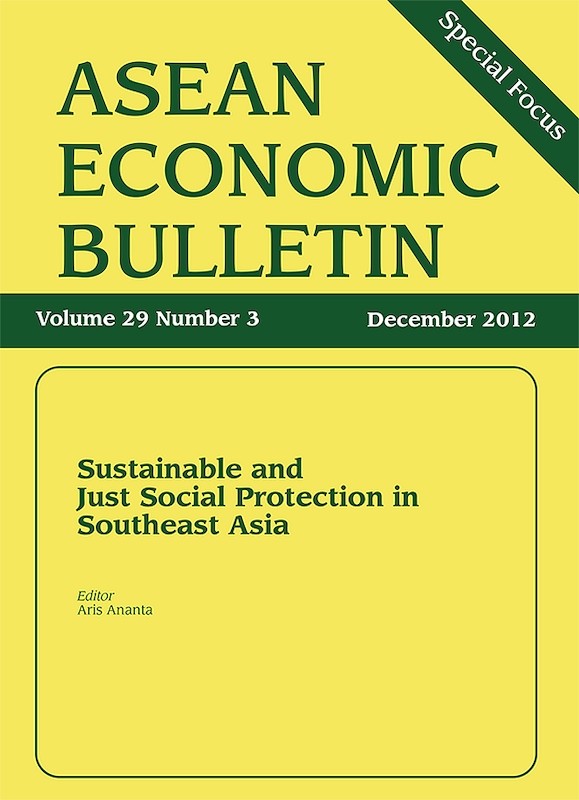
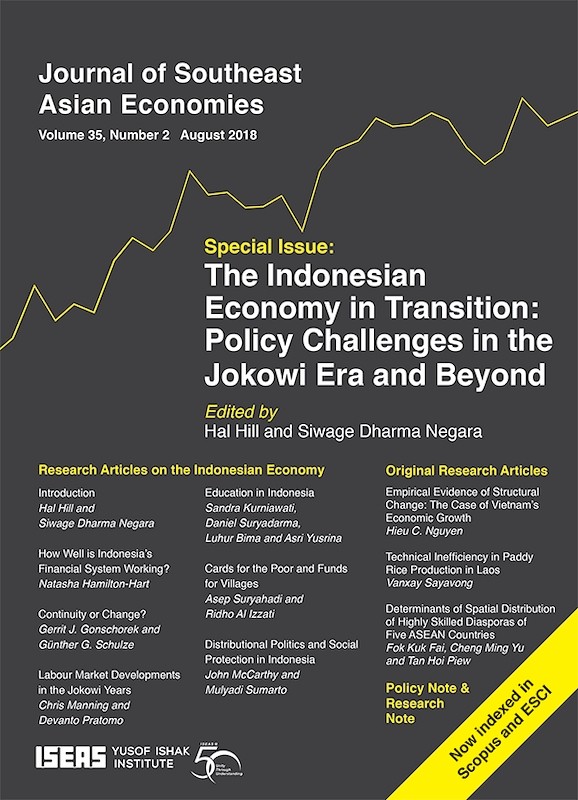
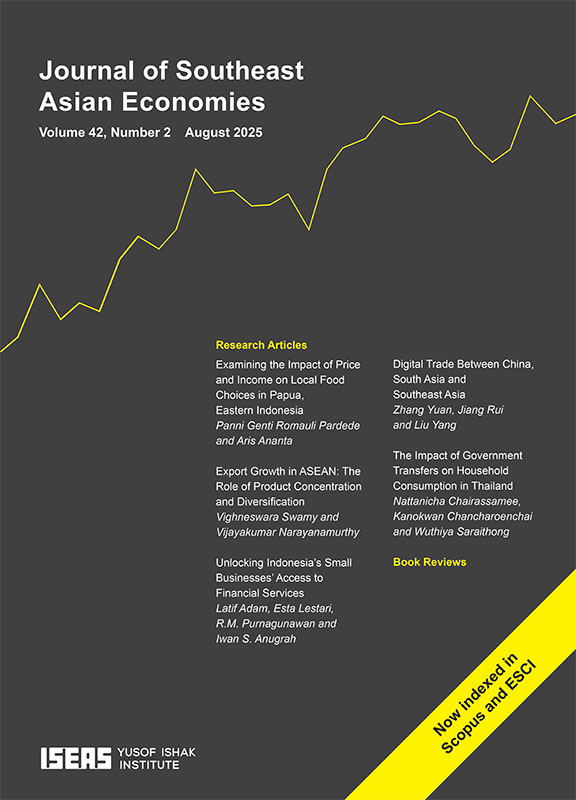
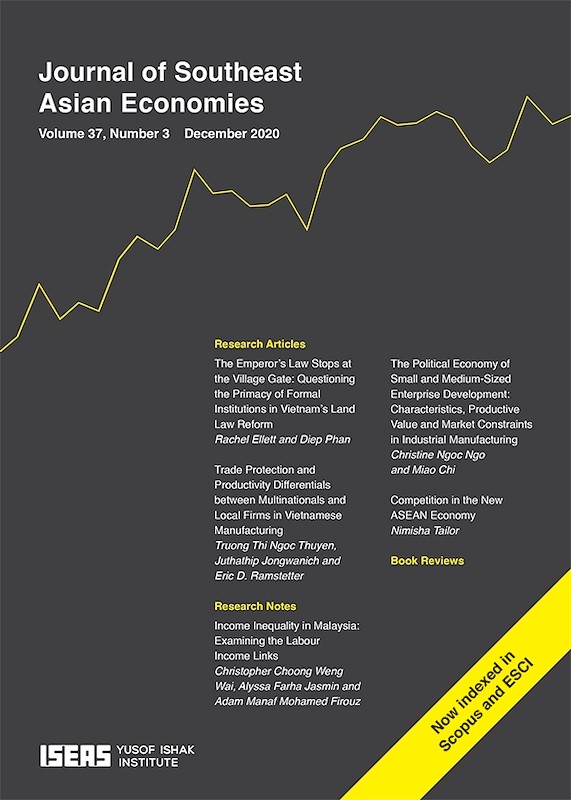
![Journal of Southeast Asian Economies Vol. 30/1 (Apr 2013) [formerly ASEAN Economic Bulletin]](/cover/AE30-1.jpg)
